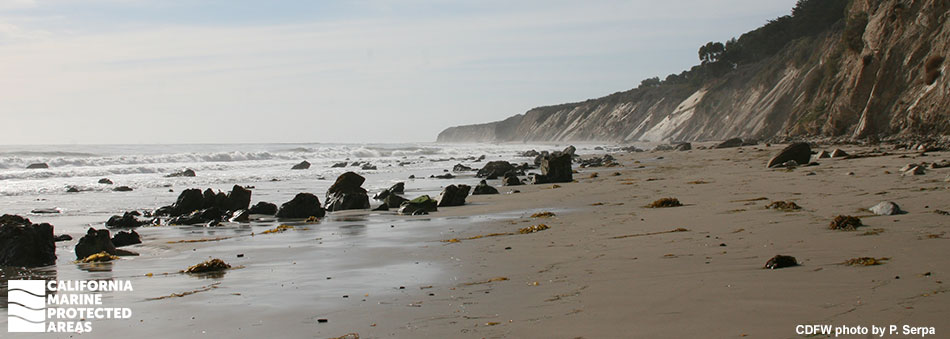
Overview
Naples State Marine Conservation Area (SMCA), encompassing less than three square miles, is one of the smaller marine protected areas (MPAs) in California. Despite its small size, this SMCA is considered an ecological hot spot. It is located just west of the city of Santa Barbara, offshore of the rural Gaviota Coast, and adjacent to El Capitán State Beach. The MPA protects a unique offshore rocky reef brimming with exceptional seafloor diversity, intertidal areas, surfgrass, kelp forest, and a harbor seal haul-out.
Offshore, the seascape includes a 30-foot reef wall covered in marine life, unique underwater pinnacle and arch systems, networks of caves, and thick kelp forests that provide homes for anemones, nudibranchs, cowries, and fish like kelp bass, California sheephead, white seabass, and yellowtail. This iconic area is frequently visited by divers, surfers, kayakers, and scientists conducting long-term research and monitoring. Marine mammals are easy to spot from shore, with sea lions feeding near the shallow rocky reef and harbor seals sunning on the coastal rocks.
Regulations
It is unlawful to injure, damage, take, or possess any living, geological, or cultural marine resource, EXCEPT:
Recreational take of white seabass and pelagic finfish (northern anchovy, barracudas, billfishes, dorado (dolphinfish), Pacific herring, jack mackerel, Pacific mackerel, salmon, Pacific sardine, blue shark, salmon shark, shortfin mako shark, thresher shark, swordfish, tunas, Pacific bonito, and yellowtail) by spearfishing is allowed. Commercial take of giant kelp is allowed. Includes take exemptions for the following tribe:
- Santa Ynez Band of Chumash Indians
California Code of Regulations Title 14, Section 632(b)(98)(opens in new tab)
Quick Facts
MPA size: 2.60 square miles
Shoreline span: 1.9 miles
Depth range: 0 to 162 feet
Habitat composition*:
- Rock: 1.48 square miles
- Sand/mud: 2.00 square miles
*Habitat calculations are based on three-dimensional area and may exceed the total MPA area listed above.